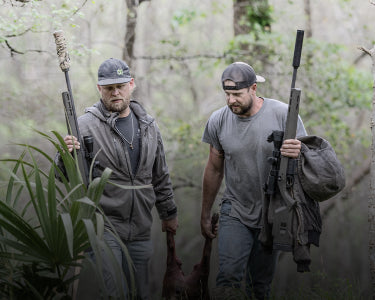The legacy of long-range precision competition shooting began in 1903 when a government advisory board called the Corporation for the Promotion of Rifle Practice and Firearm Safety, Inc. developed the National Matches to encourage national defense preparedness and improve our military’s marksmanship.

Often called CMP/NRA High Power, these shooting competitions have developed substantially over the years. Traditionally, NRA High Power rifle competitions were conducted using only iron sights; however, in 2016, the association started allowing optics. There are also quite a few different divisions so, depending on skill level and devotion, most shooters can find a competition that appeals to them. One of those is F-Class.
F-Class is a long-range rifle shooting competition that measures your marksman’s skills from distances 300 to 1,200 yards. A Full-Bore competition shooter from Canada, George Farquharson started F-Class in the 1990s in his elder years when his eyes aged to where he could not shoot accurately using iron sights. In 2005, it was officially recognized by the NRA.
From the prone position, F-Class shooters fire usually 3 relays in sets of 15 to 20 rounds at a six square foot bullseye target at either various distances or one fixed distance. Divided into two classes, competitors have the choice to shoot Open Class or Target Rifle Class.
Open class allows any rifle .35 caliber and above that weighs less than 22 pounds—including bipod and optic. Open Class participants can use front and rear rests. Target Rifle Class is reserved to unmodified rifles chambered in .223 Remington or .308 Winchester only and aren’t allowed to weigh less than 18.18 pounds including accessories. The only equipment allowed on Target Rifle Class rifles is a bipod or sling and optic. Target Rifle Class competitors can only use a rear rest. Muzzle devices are not allowed in either Class.
F-Class competition shooting doesn’t have many rules, that is why it is such a growing shooting sport. It is easy to learn, fun, challenging and affordable!
Here are the two major things you need to know before joining an F-Class competition.
Gear Up
For both classes, you want an accurate rifle, a clear optic with at least 20x magnification, a rear shooting bag or rest, bipod and high-quality match-grade ammo.
Rifle
Most successful F-Class shooters use a bolt-action rifle. There are plenty of affordable, good factory rifles that achieve sub-MOA accuracy. Check out the Remington 700, Savage Model 10 or 12, and Ruger M77, just to name a few. Popular F-class calibers include 6.5 Creedmoor, .243 Winchester, and .284 Winchester. Just don’t go too big, because recoil can affect your follow up shots. A 24-inch target barrel is ideal.
Ammo
Most experienced F-Class competitors reload their own ammo, but for the beginner F-Class shooter, using pre-loaded match-grade ammo is acceptable. You want a bullet with a higher ballistic coefficient of at least .450 to .500 or better with a minimum velocity of 2,650 feet per second. Hollow point boat tail is recommended.
Scope

The lack of a quality scope can ruin you in F-Class. However, there is no need to drop thousands on your first long-range scope. All you need is clear, crisp glass, a 30mm or larger tube, at least 40 MOA target turrets, a useable reticle and at least 20x magnification.
We Suggest…
The Sightmark Latitude 8-32x60mm F-Class riflescope is quite substantial with its extreme magnification range of 8x up to a staggering 32x; oversized 60mm objective lens; large, tactile, distinct-click turrets; single-piece 32mm tube, perfect ¼ MOA-per-click adjustability and an overall elevation range of 110 MOA—the windage range of adjustability also does not slouch at 70 MOA. For razor-sharp clarity, the nitrogen-purged Latitude boasts premium, fully multi-coated, anti-reflective glass and a fine-etched red/green illuminated, second-focal-plane F-Class reticle with five brightness settings.
Practice
An accurate precision rifle and clear scope certainly help increase your scores, but a lot of it comes down to you—the shooter. The key to high scores is knowing how to compensate for bullet drop so you can make your adjustments accordingly. Before competing, you will want to practice using a spotting scope, ballistic calculator, and wind meter. Begin by boresighting and zeroing your rifle and scope. Then, experiment with different types of ammo to find the best one for your rifle. Keep a shooter’s log of all your shots during practice so you can always refer to the proper adjustments. When you practice, focus on breath and trigger control, aim and overall rifle handling.
To get started in F-Class Shooting Competitions, you will need the following equipment:
- Rifle
- Ammo
- Scope
- Comfortable shooting mat
- Spotting scope
- Bipod
- Shooting rest—front and rear or just rear for Target Class
- Timer
- Wind meter
- Ballistic calculator
- Marksman’s databook
F-Class competition long-range shooting allows you to challenge yourself and push your equipment to its limits. There is a short learning curve and once you understand how to compensate for bullet drop, is a very rewarding sport.
Janet Raab, former manager of the NRA’s High-Power Rifle says, “F-Class is the fastest-growing type of high-power competition because it offers the challenge of long-range shooting in a format that is fun and easy to learn.”
So, gear up and go out there and start competing!
To find F-Class Matches in your area, click here.
For more on F-Class competition shooting rules, click here.



